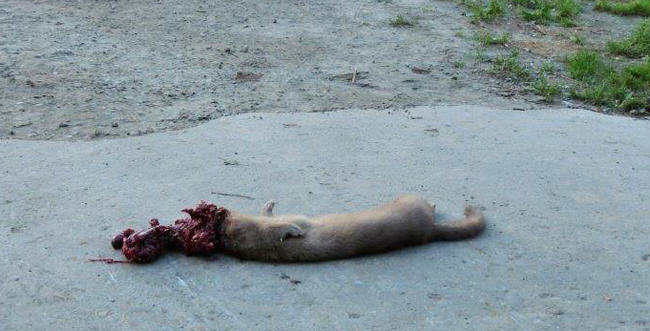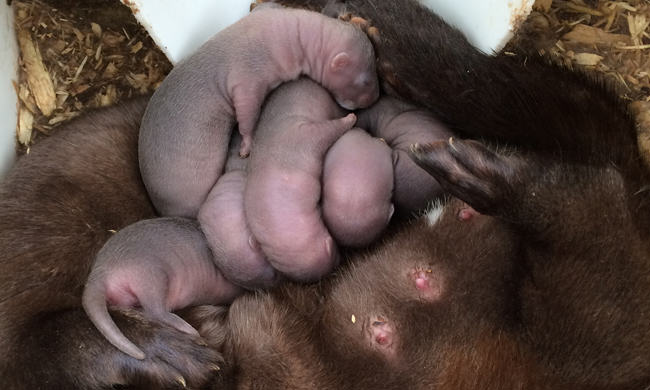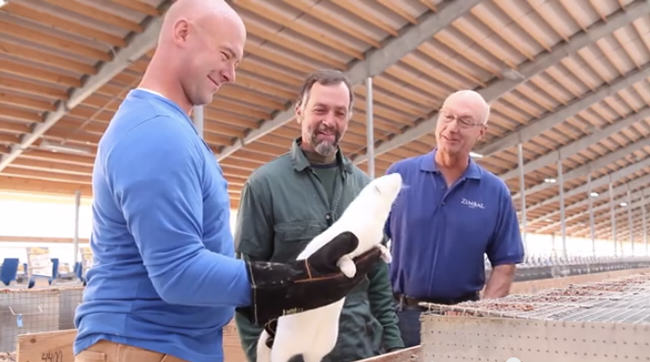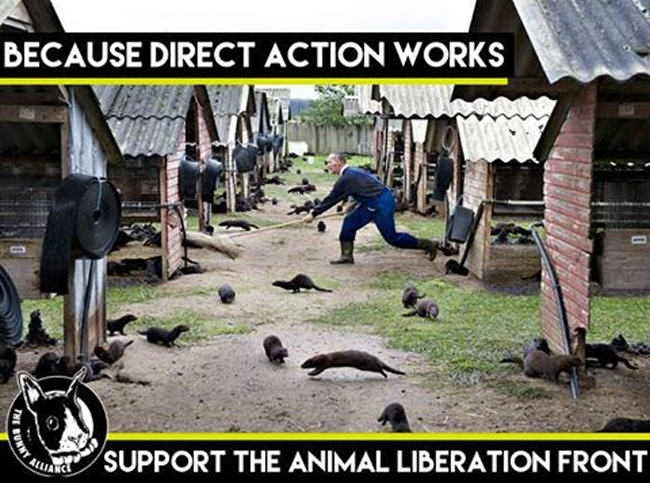
What really happens when misguided animal-rights zealots break into fur farms, cut fences, open cages and “liberate” mink? Here are five facts about “mink liberation” the Animal Liberation Front (ALF) and their activist cheerleaders don’t want you to know!
1. Most “liberated” mink don’t enjoy their “freedom” for long!
Farmed mink are not wild animals. They have been raised in captivity for more than 100 generations – that’s more than 2,000 years in human terms – and are ill-equipped to fend for themselves in nature.
In fact, farmed mink have been selectively bred to be less aggressive and have never had to hunt for their food. Many “liberated” mink therefore die from dehydration or starvation. And because they associate the sound of vehicles with the arrival of the farmer’s motorized feed cart, many are attracted to roads where they are run over by cars.
In their boastful press releases, activists never show the mangled results of these deadly encounters. The media also generally choose to protect public sensibilities. But mink farmers are left to clean up the remains of animals they cared for since birth.
The carnage is not pretty, but we decided that the public has a right to see the truth about these mink “liberations”. I took the following picture last Fall on the road outside a Quebec mink farm, the day after activists broke in and released several hundred mink. So far, no one has been charged for intentionally subjecting mink to the suffering you see here:

2. Mink that do survive, wreak havoc on local livestock and biodiversity
Inevitably, some “liberated” mink do survive, at least for a while, and especially if neighbours keep an outdoor chicken run or duck pond! The results are not good for the chickens and ducks.
Mink are notorious for going into a murderous feeding frenzy when the opportunity arises; they will bloodily wipe out dozens of hens or ducks within minutes.
Even more worrisome for biologists is the potential for the transmission of disease, to and from wild populations, and the possibility of weakening the gene pool if even a few domesticated mink survive long enough to mate with their wild cousins.
3. Releasing nursing females is just plain stupid!
Releasing farm-raised mink is never a good idea, but it takes a special sort of idiot to break into a farm while the females are nursing their young. This is exactly what some still-unidentified pea-brains did last month in southern Ontario. During the night of May 30-31, they cut the perimeter fence of a mink farm near the town of St. Mary’s and opened the cages of 1,600 nursing females.
The young kits, just 2-4 weeks old, are completely dependent on their mothers. With little or no fur (some still won’t even have their eyes open), they can easily die from hypothermia or dehydration. The farmers spend long hours in the barn through this critical period, to ensure that the kits are nursing and well cared for.

Luckily, most of the females “liberated” in St. Mary’s did not go very far when their cages were opened, precisely because their young kits were nearby. So most of the females were quickly rescued, but there was no way of knowing which litters belonged to which!
Farmers will sometimes move nursing kits from large litters to be adopted by a female with fewer young. But this is done slowly and carefully, to ensure that the female will accept her new charge. But in St. Mary’s, there was no choice but to return the females to cages at random, and hope that their maternal instinct would win out.
4. The livelihood of small family farms is put in jeopardy
A farm invasion is clearly very damaging: the female mink have been fed and cared for since the previous year, and the kits represent the income needed to cover these and other expenses. The damage to the livelihood of the farm family, however, goes far beyond these immediate losses.
The success of a mink farm is directly related to the quality of the fur produced. Fur quality, in turn, is determined by nutrition and care, but also by genetics. Each year, mink farmers carefully select the animals they will retain for reproduction; they are constantly working to improve the quality of their herd.

Tragically, although most “liberated” mink are quickly recovered, their genetic history is usually lost. Breeding records are kept on cards attached to the mink pens. But there is no way to know which pens the recovered mink were released from. Since many North American farms are now operated by a second or third generation of the family, decades of genetic records – and work – are lost.
ALF criminals know all this: on their websites they brag about destroying breeding records and encourage others to do the same. How can these misguided activists claim to be “non-violent” when they destroy the life-work of several generations?
5. Mink “liberations” are a direct attack on democracy and everyone’s freedom!
The recent attack on the St. Mary’s, Ontario mink farm occurred on a weekend billed by radical extremists as “a day of direct action”.
Responsibility for the attack was claimed by an anonymous group in a “communiqué” (ALF’s preferred term for a press release) posted by the “Animal Liberation Press Office”.
SEE ALSO: AFTER 50 YEARS, FUR TRADE TURNS TABLES ON ACTIVISTS
The communiqué makes chilling reading for anyone who values democracy and personal freedom. In addition to the muddled collection of misinformation (e.g., claims that farmed mink are “mercilessly trapped in painful leghold traps” and suffer “a painful and agonizing death” on farms), the text states openly that Animal Liberation Front activists are using “economic sabotage” to raise costs for people working with animals, with the goal of putting them out of business.

On a personal level, farmers and their families are being terrorized by these attacks on their property, their animals and their livelihoods. (Intruders are sometimes armed with baseball bats and other weapons.) On a broader level, it is all of society that is threatened by people who think their beliefs give them the right to break into private property and sabotage legal businesses.
And what do mainstream animal activist groups say about such criminal activity? Unfortunately, they often resort to Orwellian doublespeak: “We do not support illegal activity,” they insist. “But we understand why some people feel the need to stop this industry at any cost!”
Nice try. But we can turn this doublespeak on its head: if mainstream groups did not play so fast and loose with the facts in their verbal attacks on the fur trade, perhaps impressionable young activists would not be lured into such criminal activity!
***
What else do you think ALF doesn’t want us to know about mink “liberation”? Please leave a comment below! And see what Fur Commission USA has to say about mink “liberation”.











What truthaboutfur.com DOESN’T want YOU to know….
The minks that are released have a chance of dying…and a chance of living.
The minks that don’t get released will die.
Lets just get down to brass tacks shall we?
The farmers aren’t upset their minks are dead. They were going to kill them anyway. Yes, Even those smiling guys holding that white cutie……
The farmers are upset that they can’t rip the skins off of the minks to sell them.
Why does it matter that this is their “business”. Don’t you think human traffickers call their livelyhood a ‘business’. Don’t you think people who kill people for money, use the money to pay their light bill and send their kids to college? Lots of people do horrible things to support themselves…why is that an excuse? Dear God…..don’t let be an excuse…that’s one slippery slope.
truthaboutfur.com also doesn’t want you to know that when people wear fur they look like streetwalkers from 1982……or their pimp.
I wear my own skin.
It’s really not true to say we don’t want people to know some things. For example, it’s obvious that a few released mink will likely survive longer than if in captivity, especially if it’s summer and they’re surrounded by chicken farms and koi ponds. And yes, everyone knows that even Mafia hitmen have to pay their light bills. (By the way, some animal rights activists have made dodgy career choices too.) And yes, it’s possible to wear fur and look like a 1980s pimp, though that’s not necessarily a bad thing, is it? It’s just a look (think Floyd Mayweather) that some people like. Keep probing for our weak spot, and we’ll let you know if you come close.
Your ideals are your weak spot. I don’t need to point it out. Look at your website, read your own arguments, lol, You already know…..
That’s not an argument at all 😀 Keep trying …
The irony to me is the activists loudly denouncing the wearing of sustainable farm raised fur as they sport clothing made from petrochemicals, drive cars fueled by petrochemicals, heat and light their homes with energy supplied by petrochemicals.
Petrochemicals are composed of dead animals and plants, killed 1000’s of years ago. The difference? We weren’t witnesses to it. Was a dinosaur more humanely killed when it got stuck in a flood, snowstorm, muddy watering hole, slowly dying of starvation, drowning, freezing?
For me, wearing a fur coat is more cost effective than another commenter’s premise that there are synthetic alternatives available. A great fur coat will last decades. An acrylic or polyester coat will last 2-5 years with normal wear, or less, if the wearer tires of the style. It is sustainable to wear fur, it is warmer than synthetics, contains no harmful chemicals, and does not deplete irreplaceable natural resources.
Unless an activist is vegan, wears only natural fiber clothing, sustainably produced and humanely manufactured on human powered looms (since gas/electric powered looms would also deplete gas and oil resources), supplies their own energy via solar or wood burning (tree killers unless they stumble across a fallen dead tree), and drives a solar or vegetal oil powered vehicle, they’re deeply misguided about their “cause”, and hypocrites to the bone.
Excellent article and information.
Corn is people too
Life feeds on life
Carrots do not want to be eaten alive
even ALF kills everyday
This is the most stupidest thing I’ve heard anyone say. Thanks “Colleen” for setting a great example for ignorance and blatant stupidity.
I think almost everything that I wanted to say was already said, so I will weite just a few words.
The article should be called „5 things the ALF doesn‘t want you to know about their mink liberation“, because you don‘t say anything to their other actions. Also, I think this article is written by someone who doesn‘t like the ALF because their are a lot of suspect and almost forced arguments. For example: „How can these misguided activists claim to be „non-violent“ when they destroy the life-work of several generations?“ I think „destroying the life-work of several generations“ is valid if it includes killing animals for the „needs“ of humans. They don‘t hurt anyone physically and I think lives matter more than money.
But to be honest, I think the liberation of minks ON THE FARMS in general is a little bit stupid. Why don‘t they take care of them for a few weeks and at least try to reintroduce them to the nature?
By the way, a picture of three men smiling at a white mink and hundreds of cages around them won‘t make fur more humane (I laughed so hard when I saw this photo).
At least we agree that it’s stupid to release mink on farms. There are several reasons why activists don’t seek to take care of the mink and slowly reintroduce them to nature. For one thing, while farmed mink are considerably more docile than wild mink WHILE THEY ARE ON THE FARM, once they’re released and scared, they are very difficult to handle unless you know what you’re doing. Remember, they have very sharp teeth.
I bet every member of Alf kills every day..unless they don’t eat anything
LIFE FEEDS on LIFE
they should teach the minks how to find food , and teach them how to scaveng and not reliy on there parntes. Then relis them.
Hopefully they bite your arm of!
I don’t know how people who defend the biggest mass murder of innocents in history sleep at night.
Put yourself in the animals’ position, living in a cage so small you cannot even turn around, all leading to death via anal electrocution. All so some arrogant society could wear your fur.
And then you people actually have the audacity to say it’s okay, “cos democracy guys and like a just cause”
I’m ashamed to be human
Thank you for your perspective, Vego. Presumably you are vegan because, as you surely know, the numbers of pigs, poultry, fish etc. that are used to feed humans is infinitely higher than the number of animals used by the fur trade. That’s not an argument in favour of, or against, fur. It’s just a statement of fact. Perhaps you could clarify what you mean by “the biggest mass murder of innocents”. Are you referring just to the fur trade, or to all consumptive use of animals by humans?
Animals aren’t people, and they don’t get “rights”. Animals are here for humans to use wisely. Renewable, sustainable, beautiful…..what more could a person want!
Animals are for us to use…..Says who? You?
Are you deciding for all of humanity what animals are on earth for…maybe you could enlighten us on what any of us are here for…..
Hey Vego…what did you kill today??? A carrot or corn??? I will only agree with you if you if you never eat again
Hey Vego..what did you kill today? A carrot?
Are you stupid or something?
Are you seriously comparing the ability to FEEL and THINK of an animal is comparable to a carrot….
You sound like an idiot.
Good article. You’re absolutely right.
Activists should not be permitted to interfere with legitimate, legal business activities. Their actions are selfish and exhibit a childish worldview where nothing and no one else is as important as their wants and offended sensibilities. I suppose having such out-of-touch loonies is a sign of a successful and free society.
Business is business, right?
Capitalism speaks. You should be ashamed of yourself. This planet would be a better place without people like you.
Really Andy? Activists are selfish? Not the people killing animals to make luxury items for profit? When you make money, you’re a legitimate business. When you risk incarceration and fines, you’re a ‘loony’ bullshit.
You ar right, they don’t need your mad up rights, they need to be free. People should leave them in peace. As far as people like you are concerned, this planet would be a better place without the likes of you.
And actually, mink don’t cause havoc on the ecosystem, at least not for long, as they quickly disperse and find their own territories, same with foxes. Reports by farmers themselves indicate they are able to find their own food. Their genetics, if they survive, will be absorbed into the wild mink population.
Sigh.
1. Even if the mink die, it is better than dying on a fur farm, it isn’t like they were going to live much longer there.
2. The ALF recommends against releasing nursing females
3. ALF actions are all about freedom, freedom for animals as well as people.
4. Horrible practices cant be condoned just because someone makes money from it
what about freedom for carrots?? freedom for apple trees to let their babies fall and grow???freedom for all life no more farms of any kind
As a biology teacher who supports dissection as an educational tool, we are happy to take skinned deceased mink from fur farms to use in our anatomy and physiology curriculum. The students don’t get as upset as when cats are used plus the mink go to a noble cause. Technically any animal sacrificed for science goes to a noble cause! I had the worst internet flame fest a while ago with the PETA and ALF wackos who attacked me because I failed a student when she refused to dissect a cat…a requirement for her elective A&P course! You can’t reason with people like them.
Sure, a noble cause of being cut apart for nothing.
You were wrong to fail a conscientious objector.
I assume you will not avail yourself of any medicine that emanates from animal experimentation. Since most modern medicine has this connection your life will, unfortunately, be short.
Animal testing is extremely outdated requirement for medicine. Most modern medicine benefits far more from computational testing. This isn’t the 1900s anymore. This is why animal rights groups protest the use of animals in testing, and why the ALF constantly targets research and testing labs due to the atrocities committed in labs.
This information is incorrect. Scientists have made significant steps in refining, reducing and replacing animal testing but the reality is the use of animals cannot be completely eliminated. Regulatory agencies worldwide require that laboratory animal studies are conducted to help determine the efficacy and safety of new chemical entities destined for human or animal use.
This comment has been removed because it does not conform to our guidelines.
I like how you say ito lucky that the females got rescued just so you can gas them so you can wear their fur when there are about a million alternatives
Most livestock raised on farms will ultimately die to serve human needs; that’s why they are there. What is important is to ensure their welfare (proper nutrition, housing, care) during their lives, and a quick and humane death when it’s time to euthanize them.
Fur doesn’t qualify as a human need. We don’t need it anymore. There are much more ethically sound and environmentally sound materials to keep us warm. Your misguided propaganda is sickening. Also, mink were on this Earth far before they were bred for fur purposes, so your stunningly simple “that’s why they are there” comment reads as sadly ignorant.
Really? Cold-weather clothing is a human need, and the strongest ethical argument in favour of fur is that it’s an “environmentally sound” way to produce cold-weather clothing. Re: “that’s why they are there,” you realise of course that this refers to why mink exist on farms, not to why they exist, period.